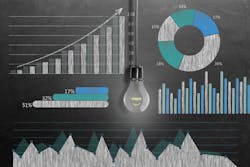Data and Utilities: Gaining Insight to Reduce Inefficiency, Enhance Value
Over the past two decades, power and utility companies have invested ample financial resources into leveraging data and analytics to increase efficiency and accelerate revenue growth. Analytics enables the possibility of developing stronger methods to manage energy production and distribution, while also enabling improved customer relationships.
But today, the full benefits that analytics can offer are not fully tapped into by utility companies. These organizations can be risk-averse, reluctant to change proven processes or invest in data and analytics unless there is some recognizable and immediate benefit. When they do choose to incorporate analytics, utility companies may not leverage their data in the most advantageous way, or potentially not effectively join their many sources of data.
While other industries and leading tech organizations have few restrictions in dedicating ample financial resources to data analysis, utility companies may not have the freedom to explore data’s full potential, often to their own detriment. Data and analytics reap the most rewards when they are used to better solve problems, gain perspective from history to address energy issues before they occur, and improve relationships with customers.
Utility companies can use analytics to pull insights from data that can help solve problems and find alternative courses of action. This could include a data analyst within a utility organization finding remedies to inefficiencies in meter measurement by applying descriptive, diagnostic, predictive, and prescriptive analytics, methods that indicate why the inefficiency happened and what can be done in the future to prevent it.
Utility companies can also use data analytical tools and storage systems, like those listed in Gartner’s Magic Quadrant research, to organize and interpret large swathes of data, such as water or electricity usage by every resident within a certain zip code. The analysis of data, as well as its mass collection and organization, can offer potential solutions to common utility issues, such as the estimated damage caused by a broken water tank.
Utility companies have an opportunity with analytics to identify or predict certain problems before they occur. Predictive and prescriptive analytics help show us what may happen in the future and what we can do to address those outcomes. This could be as simple as using analytics helping establish a utility customer’s normal consumption and determining if future anomalies, such as a consumer using three times their normal monthly amount, are indicative of a larger issue, like reduced energy efficiency or the need for repairs and upgrades.
Analytics can help indicate and prevent more widespread utility issues beyond a single consumer. For example, if there is a neighborhood where homes were all built in the 1960s, it’s possible those homes have older windows with poor insulation. That collection of homes could cause a needless, widespread depletion of valuable energy resources, simply because those windows and insulation have not been improved or replaced over the past five decades. The collection of data of how many homes may potentially have these older windows, as well as the analysis of how much energy may be wasted because of these windows, can help identify improvements that can reduce prices for consumers and increase efficient energy delivery for the utility company.
Data and analytics are also beneficial in helping remedy an individual’s own energy usage and potential waste behaviors. A person who is dedicated to reducing their individual carbon footprint may drive an electric vehicle (EV) and eat only organic goods, but this person may not realize the extent of energy wastefulness that builds up simply from leaving their front door open as they carry in their organic groceries from the car each week. Analytics can help pinpoint the energy effect of that individual’s actions, as well as similar actions among other individuals in a particular neighborhood or area.
There are additional advantages of data and analytics when applied to a utility company’s relationship with its retail customers. These tools can help determine how many individuals in a city may experience outages because of an emergent event and notify those residents ahead of time of potential lack of service. Through proactive engagement, customers will then have realistic and reliable estimates as to when their services may be functional again versus the empty speculation these companies might provide if they didn’t enable actionable information. Data and analytics can further help drive the collection of information that indicates potential large-scale changes that can benefit customers, such as using distributed or alternative assets for a particular community, which can lead to reduced monthly prices and increased reliability of microgrid redundancy.
Ultimately, leaders and managers within utility companies have the strongest voice when incorporating data and analytics into their daily procedures. There will be pain points and issues that arise when incorporating data and analytics more robustly into utilities, just as any other major organization initially struggles when first implementing a new type of technology or digital service. However, the long-term benefits of widely adopting data and analytics by utility companies, for saving energy and money, reducing inefficiencies, and improving reliability, outweigh the short-term growing pains.
Professor William Doering, adjunct professor in the Online Master’s in Business Administration program at Maryville University.
About the Author
William Doering
William Doering is a principal director at Accenture, where he leads Accenture's Advance Metering Operation practice for North America. Additionally, he is a professor at Maryville University's John E. Simon School of Business in St. Louis, Missouri, teaching courses in data analytics. For the past 15 years, he has been supporting power and utility clients through many initiatives including smart metering, AMI/MDM, ERP integration, plant accounting, asset management, and data governance and analytics.
